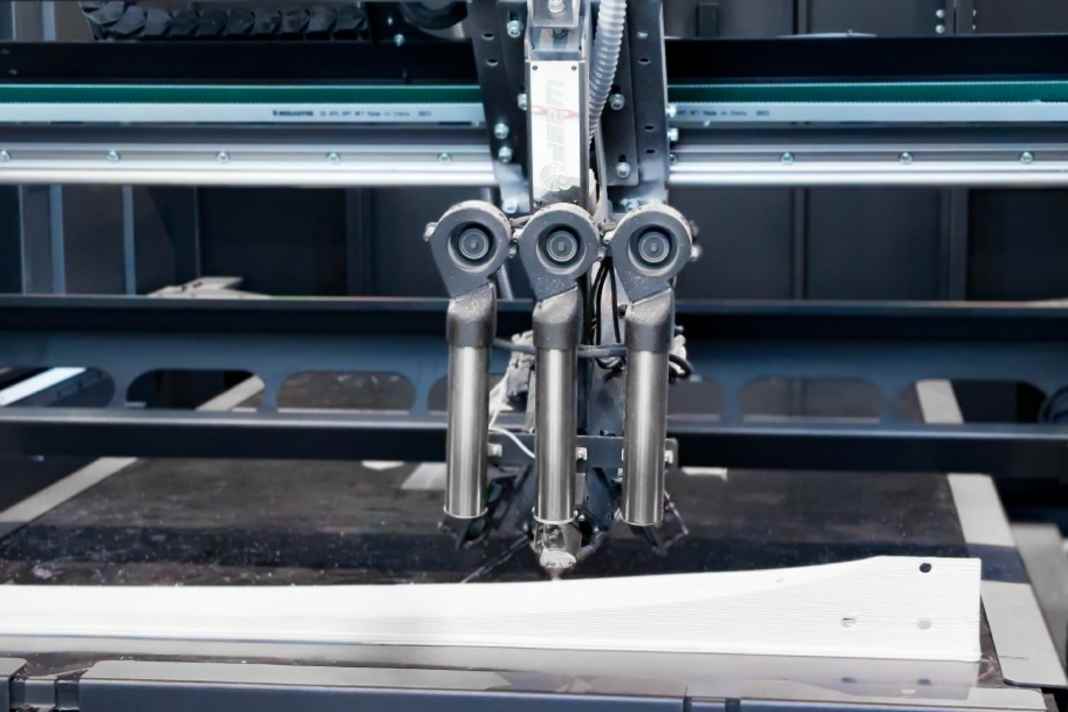





One layer at a time. The implementation of 3D printing in boatbuilding is progressing in the same way as the creation of a workpiece using additive manufacturing. Initially, it was samples as part of the development process (rapid prototyping) or equipment such as Blocksadditive processes are now used throughout to produce monolithic hull structures. Back in 2019, a university project on the US East Coast succeeded in producing a 7.80 metre-long motorboat using a 3D polymer printer and partly bio-based raw materials such as cellulose filaments. However, the grooved centre console, which still had to be milled from the printed frame, weighed 2,260 kilograms when ready to drive.
Industrial robot + extruder = 3D printing XXL
In 2021, Caracol boasted the world's first 3D-printed sailing boat. The Italian manufacturer of oversized 3D printers built a 2.80 metre long dinghy hull without a mould and in one piece. A six-axis industrial robot from Kuka, which ran pre-programmed paths for forty hours with an extruder on an articulated arm, was a key element. The actual layer application was carried out by a heated nozzle from which molten thermoplastic granulate (recycled polypropylene with 30 per cent glass fibres) emerged. "Beluga", the dinghy from the 3D printer, was subsequently stripped of its characteristic grooved surface, but is unlikely to be lighter than a composite construction. Caracol did not provide any weight details. But for comparison: the hull of a six metre long engine catswhich was produced with a machine from the Italians in a similar design at the beginning of 2025, weighed 1,200 kilograms after printing.
As the technology advances, closed devices are also coming into focus, as we know them from non-commercial solutions. But much larger. With the Power Wasp 45 HDP, Italian manufacturer Wasp has customised a 3D printer to the needs of the nautical sector. External dimensions: 4.7 x 2.5 x 2.6 metres. The special feature: The extruder-nozzle unit creates printing processes at a 45-degree angle, which enables complex geometries and means that supports are no longer required on a large scale. The steep layering is also designed to minimise warping, material consumption and overhangs.
Mould making with 3D printing system
One of the first users of the Power Wasp 45 HDP was the Polimi Sailing Team, which elicited the negative mould for the hull of a moth from the one-tonne 3D printing machine. The process materialised four precise parts of similar size, some with hollow walls. Thanks to additive manufacturing, the sailing team at the Milan Polytechnic did not have to produce a master model. The students also reduced costs, production times and material consumption. In post-processing, the use of filler was considered more sustainable than milling techniques.
The Polimi Sailing Team won the Foiling SuMoth Challenge 2024 with the finished moth called "Febe" - made from basalt fibres, thermoplastic resin Elium and core material made from recycled PET. This was the sixth time that the competition was about maximum sustainable moths for foiling. The overall winner is determined in three categories: Development, Construction and Proof of Practice. The flying prototypes have to prove themselves in speed runs and races on Lake Garda.
Maritime competence centre for 3D printing
Robot-assisted additive manufacturing systems can even take on mould construction on a large scale. After all, it is all about high precision and - if large quantities are not expected - the lowest possible costs and high flexibility. In Hungary, a master model was created for the hull mould of a 55-foot motorboat from Como Yachts. An extruder from CEAD in the Netherlands was used, which printed a total of 44 sections from 5,000 kilograms of recycled PETG. These were laminated together and milled smooth using a CNC machine. The advantages: Only three people worked on the original model for twelve weeks, making it easier for them to produce the actual GRP mould due to the lower weight compared to MDF blocks.
CEAD states that master models are possible that are made up of larger sections and therefore require less gluing. It is currently producing the deck of a 35-foot boat, which is based on 50 per cent 3D-printed moulds. The Dutch company was formed in 2014 as a spin-off from Delft University of Technology, where the founders developed a 3D printer for end consumers during their studies in 2010. CEAD recently opened a centre of excellence for large-scale additive manufacturing at the same location - with a focus on the maritime sector. The Maritime Application Center (MAC) can print monolithic hulls up to a size of 12 x 4 x 2 metres. A recycling facility with a large shredder is also to be built to support research into the recycling of printed parts and entire boats.

